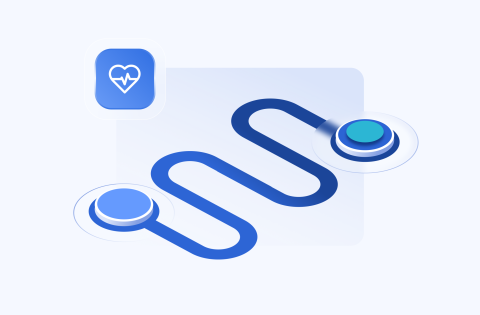
- MedTech
Unleash the Potential of Telemedicine in Your Medical Facility
Interest in telemedicine has skyrocketed in the United States. Despite a 10% decrease in its utilization in 2022 compared to the previous year, the number of users was still significantly higher than before the pandemic. According to a recent study conducted in the United States in 2022, 38% of respondents used telemedicine applications in the past year.
All forecasts regarding telemedicine indicate that its dynamic growth is inevitable, and according to e-Marketer, it is expected to reach up to 43.3% of the population in the USA by 2025. In this article, we will discuss how to prepare for its implementation, addressing both the technical and legal aspects that need to be considered in the process.
What is Telemedicine?
Telemedicine is a healthcare practice that leverages technology for remote consultations and medical services, facilitating the exchange of medical information, diagnoses, and treatment recommendations — without patients needing to visit medical facilities. The primary goal is to improve care accessibility, especially for those with mobility issues.
Types of Telemedicine
Telemedicine can be divided into several distinct types, each addressing specific patient needs:
Synchronous Telemedicine (Real-time Telemedicine)
This type involves real-time communication between patients and healthcare professionals. Consultations occur through video conferences, live chats, or phone calls — ideal for cases requiring an immediate response from medical staff.
Examples include:
- Online consultations with a family doctor using apps like Medicover.
- Virtual visits to psychiatrists or psychologists.
- Specialist consultations in emergencies.
Asynchronous Telemedicine (Store-and-Forward)
This form of telemedicine involves storing and forwarding medical data, such as patient information or test results, without direct communication between the patient and medical personnel. It’s useful when medical staff need time to analyze received data and establish a diagnosis.
Examples include:
- Sending images of skin lesions to a dermatologist.
- Forwarding lab test results to a doctor.
- Sharing medical history for international consultations.
Remote Monitoring
Remote monitoring entails continuously tracking patients’ vital signs using special devices, like body-worn sensors. Patient data is transmitted to medical staff, allowing personalized care adjustments and rapid intervention by doctors in critical situations. It’s beneficial for chronic illnesses and post-surgical recovery.
Examples include:
- Monitoring blood pressure and heart rate with a wristband like QardioArm.
- Measuring blood sugar levels with a subcutaneous sensor like FreeStyle Libre.
- Tracking heart function through an implanted pacemaker using Biotronik Home Monitoring technology.
 Telemedicine Solutions: What to Focus On
Telemedicine Solutions: What to Focus On
Now that we understand telemedicine and its types, let’s delve into the technical requirements for building MedTech solutions.
Using telemedicine, healthcare services are provided without traditional barriers like distance to clinics or hospitals. In this context, the technical aspects of proposed solutions play an even more significant role in ensuring service effectiveness, safety, and reliability.
Scalability
Design the system to seamlessly handle growing service demands. Scalability prevents overloads and enables the platform to accommodate more patients.
Reliability
Service disruptions or interruptions are unacceptable. Hosting solutions must provide continuous access to medical consultations, treatment sessions, and data storage. Reliability builds trust among patients and maintains a good reputation for the institution.
In addition to hosting service providers, the software house responsible for the project plays a crucial role in configuring and maintaining cloud infrastructure for uninterrupted and efficient medical services.
Stability
Telemedicine relies on real-time audio and video communication. The stability of the telecommunication infrastructure is essential for clear and continuous connections, improving the quality of consultations and preventing disruptions that could negatively affect interactions between patients and doctors.
Data Security
A detailed security risk assessment is necessary before developing a medical app. This analysis covers various aspects of information safety, from determining the organization’s compliance level to evaluating internal policies and IT infrastructure.
Implementing proper data management principles and security practices is critical in ensuring compliance with health information privacy laws. Consider aspects such as regular backups, data recovery plans, the right to be forgotten, and effective access controls and user authorization.
Technical measures like encrypting data during transmission and storage and following HIPAA guidelines are equally critical for maintaining the confidentiality of patient information. Implementing data audits allows monitoring and analysis of system activity to identify any irregularities or attempts at unauthorized access.
Compliance with Regulations and Laws
Compliance with HIPAA (the Health Insurance Portability and Accountability Act) is crucial in the United States. These strict rules regarding clients’ privacy and upholding of legal standards. Maintaining data security and adhering to regulations build patient trust, assuring them that the telemedical platform prioritizes safeguarding their information.
Essential Telemedicine Application Features
As telemedicine evolves, it provides patients with more features. Here we’ll focus on a basic set of functionalities commonly implemented by various healthcare service providers.
Video Conferencing
Real-time communication between patients and specialists allows for assessing patients, discussing symptoms, prescribing treatments, and addressing medical issues. This form of communication restores the human dimension of healthcare, facilitating an understanding of patient needs and tailoring therapy to individual requirements.
Secure Messaging
Secure messaging serves as a communication channel between patients and healthcare providers. This feature is crucial for asynchronous communication, enabling patients to contact healthcare teams, share information about their health status, ask questions about medications, seek advice, and receive prescriptions. Secure messaging facilitates communication and prompt problem resolution while maintaining complete privacy and security of sensitive data.
Appointment Scheduling
Appointment scheduling features are a vital component of telemedical platforms, offering users a simple and efficient way to book consultations and streamlining the organization of appointments. These features assist medical facilities in managing schedules, optimizing resource allocations, reducing absences, and ensuring adequate time for each patient. Often, they also integrate with calendars and reminders, enhancing patient engagement and streamlining telemedical visits.
Online Payments
Payment integration is another function of MedTech systems, enabling easy settlement for online healthcare services. By allawoing patients to pay for consultations, tests, or other healthcare services without leaving their homes, this integraion simplifies the payment process and adds patient comfort and enhances financial management efficiency within the medical system.
Integration with EHR/EMR Systems
Integrating electronic health records (EHR) or electronic medical records (EMR) systems with telemedical platforms is a big step toward making patient data easily accessible for comprehensive healthcare.
In the United States, the Office of the National Coordinator for Health Information Technology (ONC) plays a crucial role in approving and certifying EHR systems. As part of the Department of Health and Human Services (HHS), the ONC is responsible for encouraging the adoption and meaningful use of health information technology.
The ONC’s Health IT Certification Program sets the criteria and standards for EHR systems to achieve certification.
E-prescriptions
E-prescriptions bring efficiency and security to managing patient prescriptions. Adopting e-prescriptions eliminates the need for physical delivery or paper storage, reducing the risk of document loss or damage.
In the United States, adhering to the DEA’s Electronic Prescriptions for Controlled Substances (EPCS) regulations is essential when implementing e-prescriptions. Connecting to an electronic health system involves incorporating an e-prescription module into the clinic or health information system (HIS) and obtaining certification from the electronic health system.
Alternatively, one can create an account within the designated application, ensuring compliance with DEA security standards. This comprehensive approach ensures a secure and streamlined process for electronic prescribing, aligning with both national and state-level regulatory frameworks.
 Case Study – Solution for Endometriosis Patients
Case Study – Solution for Endometriosis Patients
For our client (NDA) in Finland, we are leading a project to build a groundbreaking solution that will assist patients dealing with endometriosis.
The end product will feature various functions, including a module for daily tracking of symptoms, pain, medications, hormones, activity, etc. Additionally, the application will contain background data and 2D body images for pain tracking.
The application aims to support pain monitoring and facilitate the diagnosis of endometriosis by storing essential health information.
Currently, we are in the process of working on the project’s successive stages, focusing on creating additional prototypes. Our goal is to develop a comprehensive tool that not only simplifies daily life for patients but also contributes to better diagnosies and management of endometriosis.
Conclusion
As mentioned above, multiple elements need consideration before starting the project to create a telemedical tool. In the context of technology, crucial features include scalability, reliability, stability, data security, and compliance with regulations.
Other vital components of telemedical platforms include video conferencing for real-time communication, secure messaging for asynchronous communication, appointment scheduling for organizing consultations, online payments for settling healthcare services, and integration with EHR/EMR systems for easy access to patient data.
At Blurify, we are ready to build advanced telemedical systems. Equipped with comprehensive knowledge and skills, we ensure scalability, reliability, stability, data security, and compliance with the highest standards, including stringent HIPAA regulations.
If you have questions about developing telemedical applications or need support in implementing specific features, contact us. We’ll provide a free evaluation of your idea and help bring it to fruition.



 Case Study – Solution for Endometriosis Patients
Case Study – Solution for Endometriosis Patients




